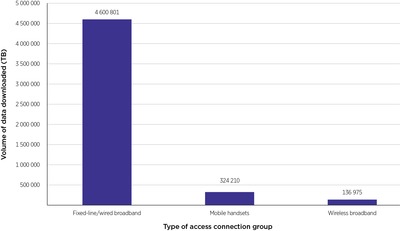Mobile handsets most popular for internet access: ACCC

The most common way for consumers to access the internet is via mobile handsets, according to a new ACCC data report about internet activity.
Meanwhile, the report for the period ending 31 December 2018 indicates that the largest volume of data is downloaded over fixed lines.
It also provides information on the number of retail services in operation (SIOs) by connection type and download speeds as well as the volume of data downloaded within Australia.
The total number of retail SIOs reached 39.9 million as at the end of last year; 24.3 million of these were mobile handsets, 8.4 million were wireless broadband and 7.2 million were fixed-line/wired broadband.
“This report provides a clear indication that while consumers are most often using their phones to access the internet, when downloading significant content they currently favour fixed-line connections,” ACCC Commissioner Cristina Cifuentes said.

The greatest proportion of total fixed-line/wired connections was fibre connections (at 49%), with DSL connections accounting for 34%.
Fixed-line/wired technologies accounted for 91% of the total volume of data downloaded. Mobile handsets and wireless broadband contributed significantly less to the total, with proportions of 6% and 3% respectively.
“The volume of data downloaded is expected to grow exponentially as the result of the increased usage of content streaming services such as Netflix, social media such as Facebook, and applications including online gaming that continue to incorporate content-rich and video components,” said Cifuentes.

“The most popular speed tier for fixed-line and wireless broadband SIOs (excluding mobile handset) is less than 24 megabits per second,” Cifuentes said.
The speed tier of less than 24 megabits per second (Mbps) accounted for 61% of all fixed-line/wired and wireless broadband SIOs (excluding mobile handset), followed by the 24 Mbps to less than 50 Mbps (25%), 50 Mbps to less than 100 Mbps (8%) and 100 Mbps or greater (5%).
Data for the report was collected under the Internet Activity Record Keeping Rule (RKR).
In accordance with the two-tier approach of this RKR, the contents of this report will be changing from the June 2019 report onwards. The ACCC will be releasing a richer dataset of internet activity information with a greater level of granularity and disaggregation.
Please follow us and share on Twitter and Facebook. You can also subscribe for FREE to our weekly newsletter and quarterly magazine.
Ericsson unveils new wireless branch architecture
Ericsson's new range of wireless-first branch architecture aims to help businesses unlock the...
Ericsson unveils Enterprise 5G portfolio
Ericsson’s Enterprise 5G product line is aimed at improving adoption of private 5G networks...
Cradlepoint launches 5G-ready SASE solution
Cradlepoint NetCloud SASE has been designed to combine SD-WAN and zero trust networking security...




